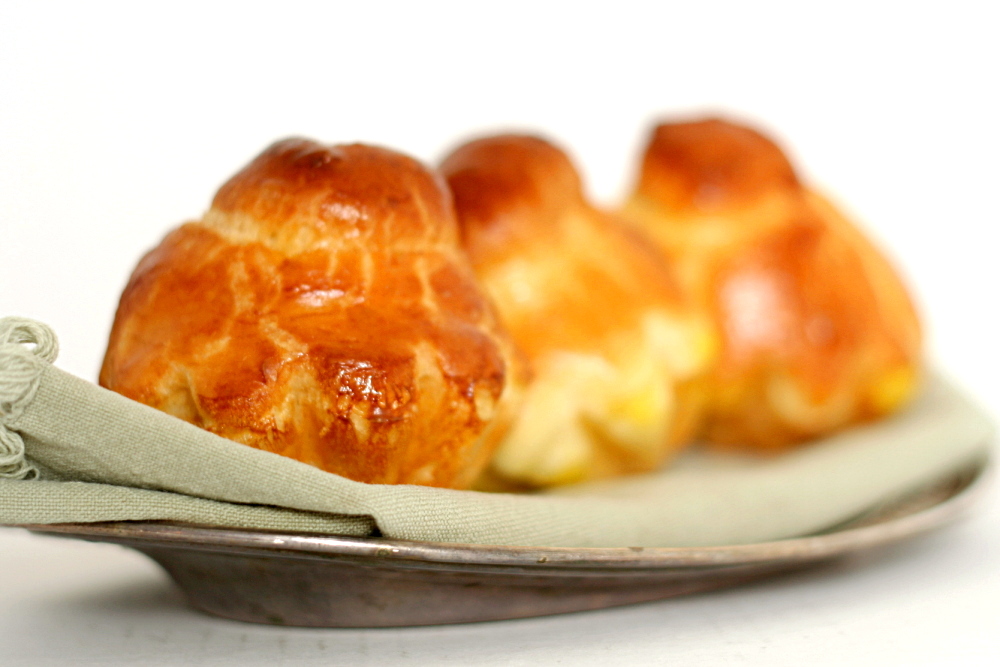
You know how you hear people talk about getting ready for bathing suit season? Um, yeah, I’m no good at that sort of thing. A month before I went on a vacation to the beach, I decided I should undertake a croissant project. A week before the trip, I made brioche. On the drive to the beach, we ate casatiello (a less rich brioche full of sausage and cheese bits). Maybe it’s maturity, or maybe it’s laziness, but I just don’t find myself as worked up about looking perfect as I used to. I’m healthy and that’ll do for now.
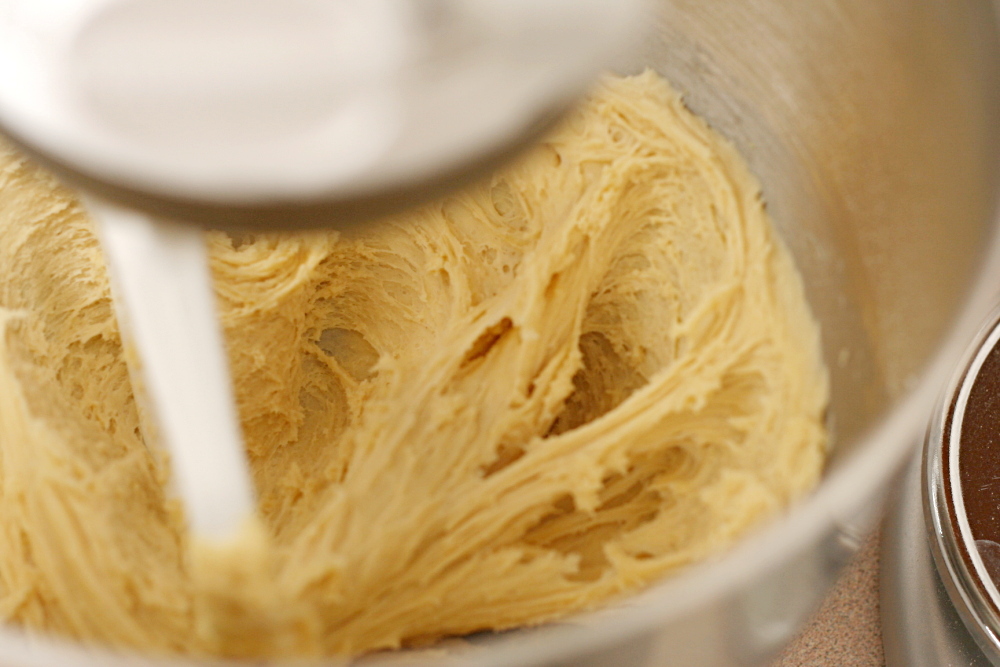
I certainly could have made the brioche less rich, if I was worried about that. Peter Reinhart gives three brioche recipes – his rich man’s brioche has the most butter, and poor man’s has the least, with middle-class brioche in between. I was having trouble choosing and eventually went with “upper middle-class brioche”, by averaging the rich man’s (buttery and delicious) and the middle class (easier to work with) recipes.
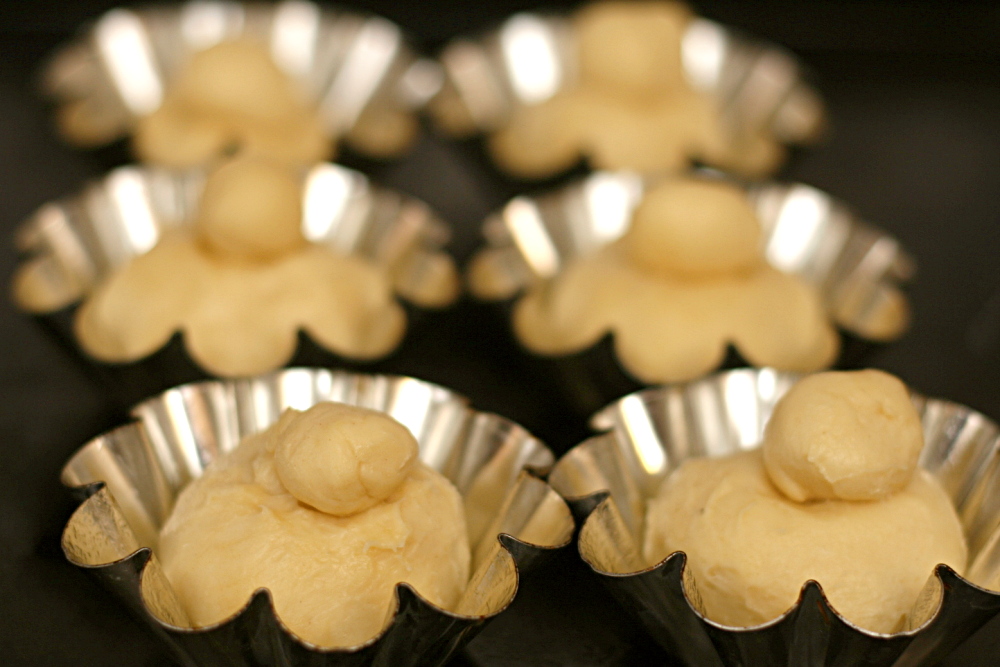
Brioche, with all of its extra butter and eggs, isn’t made too differently than any other type of bread. It starts with a sponge, because Reinhart loves his long fermentations. Then a lot of eggs are added – five eggs for the amount of flour that usually makes one loaf of sandwich bread. After the dry ingredients are mixed in and the dough starts to form, softened butter is slowly worked in. I used, I kid you not, almost one stick of butter per cup of flour.
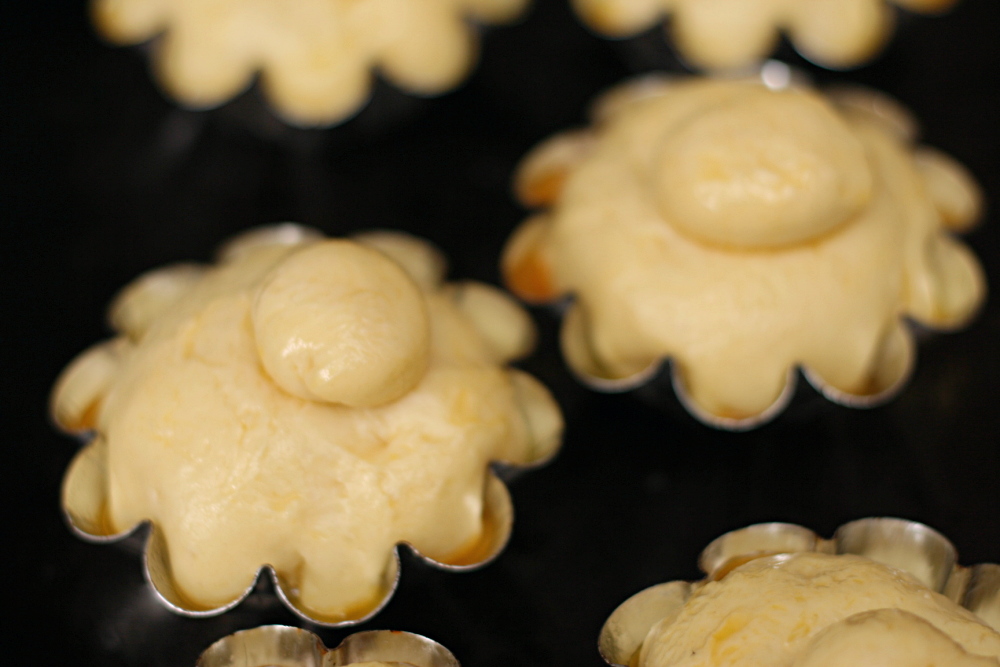
The rising process is different from the traditional bread method though, as the dough is immediately refrigerated, and needs to remain cold while it’s being shaped. It’s proofed at room temperature, then baked and slightly cooled. (For all my talk about not caring how I look in a bikini, I did go for a run while the rolls rose.)
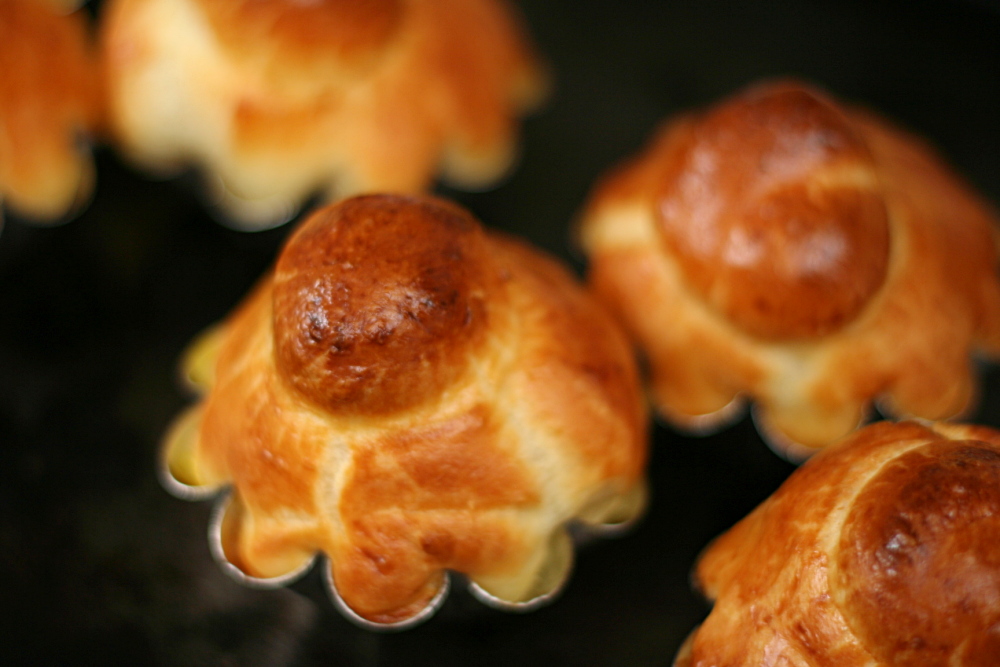
Oddly, I’m not sure I’d ever eaten brioche plain before. If I had, it wasn’t memorable. But this? Is memorable. I couldn’t get over how light they felt. All that butter is all-too-easily hidden. We ate the tender, delicious rolls plain for breakfast, and when we came home from strawberry picking in the afternoon, we toasted slices and smeared them with farmer’s market strawberry jam. I would definitely rather eat brioche than be a size smaller.
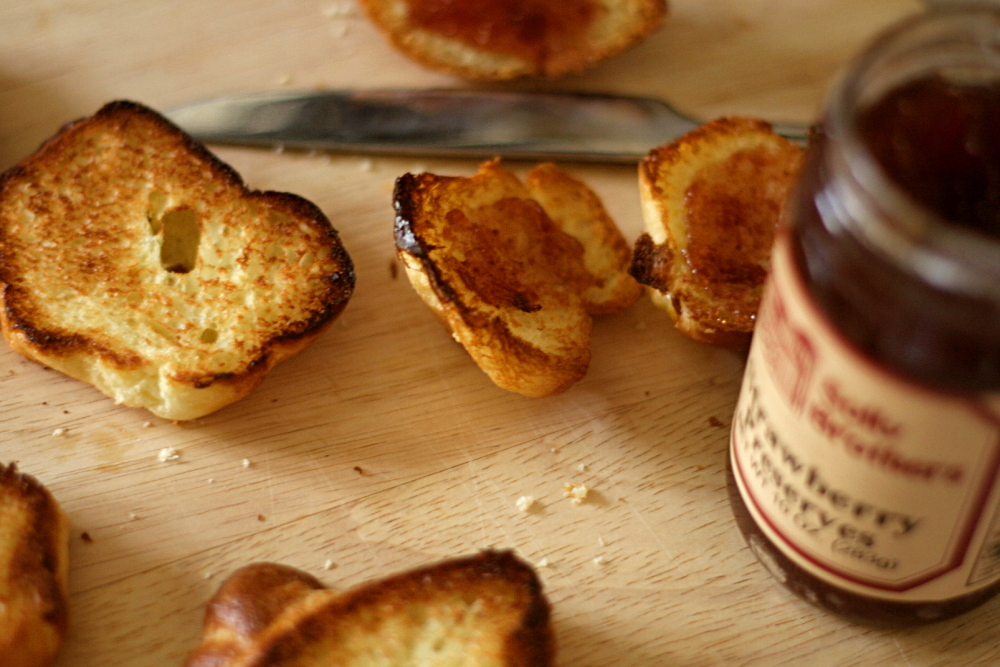
One year ago: Blueberry Pie
Upper Middle-Class Brioche (very slightly adapted from Peter Reinhart’s Bread Baker’s Apprentice)
Makes 12-16 petite brioches à tête, 2-4 large brioches à tête, or two 1-pound loaves
Sponge:
½ cup (2.25 ounces) unbleached bread flour
2 teaspoons instant yeast
½ cup (4 ounces) whole milk, lukewarm
Dough:
5 large eggs, slightly beaten
3 cups (13.75 ounces) unbleached bread flour
2 tablespoons (1 ounce) granulated sugar
1¼ teaspoons salt
24 tablespoons (3 sticks) unsalted butter, at room temperature
1 egg, whisked until frothy, for egg wash
1. To make the sponge, stir together the flour and yeast in a large mixing bowl (or in the bowl of an electric mixer). Stir in the milk until all of the flour is hydrated. Cover with plastic wrap and ferment for 30 minutes, or until the sponge rises and then falls when you tap the bowl.
2. To make the dough, add the eggs to the sponge and whisk (or beat on medium speed with the paddle attachment) until smooth. In a separate bowl, stir together the flour, sugar, and salt. Add this mixture to the sponge and eggs and stir (or continue to mix with the paddle attachment on low speed for about 2 minutes) until all the ingredients are hydrated and evenly distributed. Let this mixture rest for about 5 minutes so that the gluten can begin to develop. Then, while mixing with a large spoon (or on medium speed with the paddle), gradually work in the butter, about one-quarter at a time, waiting until each addition of butter assimilates before adding more. This will take a few minutes. Continue mixing for about 6 more minutes, or until the dough is very well mixed. You will have to scrape down the bowl from time to time as the dough will cling to it. The dough will be very smooth.
3. Line a sheet pan with baking parchment and mist lightly with spray oil. Transfer the dough to the sheet pan, spreading it to form a large, thick rectangle measuring about 6 inches by 8 inches. Mist the top of the dough with spray oil and cover the pan with plastic wrap or place it in a large food-grade plastic bag.
4. Immediately put the dough into the refrigerator and chill overnight, or for at least 4 hours.
5. Remove the dough from the refrigerator and shape it while it is very cold. If it warms up or softens, return it to the refrigerator. If you are making brioches à tête, lightly oil or use spray oil to grease the fluted molds. Divide the dough into 12 to 16 portions for petites brioches à tête and 2 to 4 portions for larger shapes. (The size of each portion should correspond to the size of the molds; petites brioches à tête are typically 1.5 to 2 ounces each, while larger versions can range from 1 to 2 pounds. Whatever size you are making, the molds should only be half full with dough to allow for expansion during proofing.) Shape the petites brioches à tête into small balls and the larger ones into round loafs. Dust your hands with flour, and, using the edge of your hand, divide a ball of dough into a large and small ball by rolling down, but not quite all the way through, the dough. Place the large ball into the oiled brioche mold and use the tips of your fingers to indent the top and to round and center the smaller ball. Place the molds on a sheet pan after final shaping. If you are making loaves, grease two 8.5 by 4.5-inch loaf pans. Divide the dough into 3 pieces and shape the dough into loaves.
6. Mist the top of the dough with spray oil and loosely cover with plastic wrap, or slip the pan(s) into a food-grade plastic bag. Proof the dough until it nearly fills the molds or loaf pans, 1.5 to 2 hours for petites brioches à tête and longer for larger shapes. Gently brush the tops with egg wash. Cover the dough with plastic wrap that has been lightly misted with spray oil. Continue proofing for another 15 to 30 minutes, or until the dough fills the molds or pans.
7. Preheat the oven to 400F with the oven rack on the middle shelf for petites brioches à tête, or 350F for larger shapes.
8. Bake for about 15 to 20 minutes for petites brioches à tête and 35 to 50 minutes for larger shapes. The internal temperature should register above 180F for the small ones and about 190F for the larger shapes. The bread should sound hollow when thumped on the bottom and be golden brown.
9. Remove the brioches or loaves from the pans as soon as they come out of the oven and cool on a rack for at least 20 minutes for small brioches and 1 hour for larger shapes before serving.
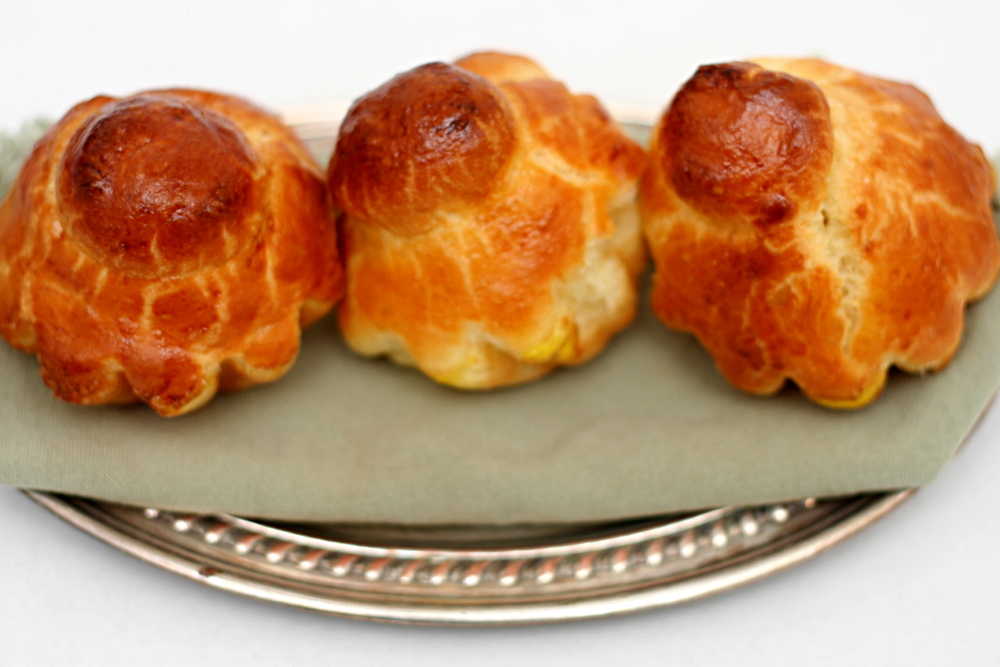






These look incredible. Great photographs too!
I ordered a sandwich the other day with brioche and I ended up with what seemed like white bread. I was so disappointed but thought maybe I just had the wrong idea about brioche. Your post lets me know I was on the right track…just wish the restaurant was too.
Those look delicious! Congratulations on a job well done! I live in limbo between baking, enjoying life and eating what I want and exercising to keep from swelling up like, well, a brioche =)
Outstanding brioche!
Beautiful shots as usual! I just made a less-buttery recipe of brioche and enjoyed its myriad uses. Croissants are also on my list of Foods That Are Not Good For Me That I Want To Make Anyway.
I honest-to-goodness NEVER knew what brioche was until I read this. Now I know, and it looks/sounds divine. Maybe one day I’ll try it. And I know what you mean about caring vs not caring. I go back and forth between the two. I was supposed to get swimsuit ready for the 4th of July. And for 1 month leading up to it I was going to follow this workout schedule that was pretty hard-core, and count calories. Well… about 1 week into it I found a one-piece suit I love (I have a troublesome tummy), and I just said “F-it”. I continued with the workout, but ate what I wanted. Didn’t lose a single pound.
Gorgeous shots!! And as for the beach diet, yeah, not so much. Found out today I’m going to the beach on Saturday and spent the day making (and sampling) pistachio ice cream, chocolate ice cream, snickerdoodles, and rum-soaked banana bread!
These are so cute!! I love your pictures too! They make me want to eat a whole “flight” of them. Haha 🙂 🙂
Those turned out absolutely beautiful.
I’m 100% with you – I’d rather eat brioche than be a size smaller. After making the middle class brioche, I believe this is the best brioche I’ve ever made / eaten. Yours look absolutely gorgeous too, with those cute little tetes!
Whoa. Those look about as perfect as I’ve ever seen ’em. Very well done. I’m starting to think it may not be SO impossible for me to try them in our heat (but then again I still don’t have a stand mixer :/
These look beautiful! I bet they taste amazing too!
Your brioche looks perfect! YUM. I want one.
Your brioche are the cutest things! Great job. I’m not so good at the beach diet either…I have no willpower to avoid dessert!
Your brioches are so lovely ! And I, too, prefer to be cool than to count every calorie I eat !
Those look great. I want to try some and I have the mini pans. Will have to try these.
Wow, what appetizing photos! I like how you averaged the run and the brioche 🙂
Beautiful photos! Those brioche are so well made. Looks delicious.
Beautiful!!!! I made brioche a while ago, it’s an amazing bread, yours is gorgeous!
I have never made brioche before but I have always wanted to try. You make it look so easy:)
Gorgeous, I’m so impressed! My mouth is watering after seeing that last shot!
Today at our little school one of the fathers came in to make brioche with our first grade class. He is a chef here in the Napa Valley., CA. ( and he is French) Well, even with kids helping the results were unbelievably delicious! I had only had Brioche from a grocery store bakery, nothing fancy. But this “chef Dad” made me understand the difference between “real” brioche and all other attempts at making brioche. Now here is his recipe. 3 1/2 cups of flour, 3 eggs, 1 1/2 cups of milk and get ready… 2 POUNDS of BUTTER. That’s right! i even gently corrected him since english is his second language. No, he insisted. POUNDS. ( He’s a very nice man and not easily offended, thank goodness!) The process is the same as a usual recipe. SO, this weekend I am going to try it out.
Very slightly adapted? This is pretty much exactly Peter Reinhart’s recipe. You just changed the increments here and there. :T